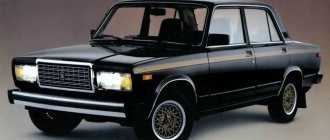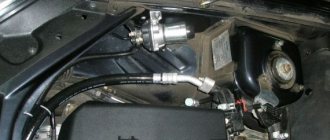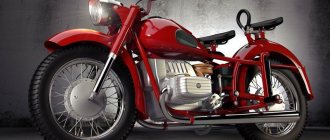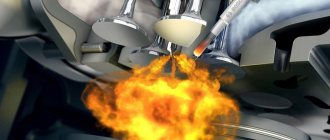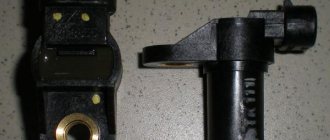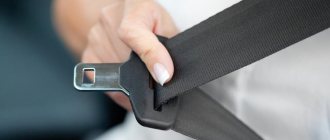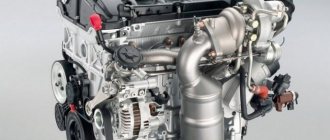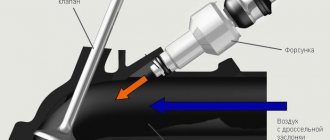Advantages and disadvantages of converting Niva to gas
There are two sides to converting a car to a dual-fuel system: positive and negative.
The main reason that drives car owners is saving on fuel.
Gas consumption on the Niva 21214 injector is two times less in quantitative terms than gasoline. Gas is much cheaper in cost, almost twice. Therefore, knowing the monthly mileage of an SUV, it is easy to calculate savings. The costs should include the cost of gas equipment, installation, modification of the muffler and towbar, the cost of registering the gas system, payment for inspections and maintenance.
It turns out that switching to NIVA-URBAN 1.7 gas equipment is beneficial when the car is almost never parked in the garage (at least 15 thousand km per year). If the engine consumes more than 6.5 liters per 100 km, then it is worth converting. In all other cases, the benefits of HBO will not immediately show.
- saving on fuel costs;
- wear of the internal combustion engine is reduced, repair costs are lower (the octane number is superior to gas);
- A big plus is that the car meets environmental European standards (methane is more environmentally friendly than a propane-butane mixture);
- the car will go along the highway more smoothly;
- the motor will become much quieter;
- the Niva's mileage between refueling increases when fully refueled with gasoline and gas;
- Spark plugs last longer.
The car will not develop speed so quickly. On the highway during active driving, you can continue to drive on gasoline, but in the city switch to gas fuel. No reduction in power will be felt.
In addition, the disadvantages of HBO on Niva are as follows:
- it is more difficult to predict the remaining fuel in the cylinder;
- in summer, the carburetor may become clogged;
- The muffler and towbar need modification.
Hydraulic compensators reduce exhaust emissions and fuel consumption.
Before making a decision on conversion, you need to calculate the economic component, take into account technical difficulties, and the consequences for the engine. A universal solution is to supply Niva with high-quality gas equipment, which will save fuel and improve the performance of the internal combustion engine.
HBO on Chevrolet Niva: the end justifies the means
LPG for Grand Vitara: is it possible to save on fuel and not spend money on repairs?
Installing LPG on Kia Rio: real savings on fuel
LPG for UAZ Patriot: installation and operating features
Installing LPG on UAZ Hunter: important points
Source
Costs of 2121 Niva on gasoline
Gasoline costs
| Volume | Transfers | Gasoline type | Gasoline consumption by road type | Price of 1000 km of gasoline, mixed mode | ||
| In the city | On the road | Mixed | ||||
| 1.6 | Mechanics | 92 | 13.4 | 7.8 | 9.8 | |
| 1.6 | Mechanics | 95 | 13.4 | 7.8 | 9.8 | |
| 1.7 | Mechanics | 95 | 11.2 | 8.3 | 9.7 | |
| 1.7 | Mechanics | 92 | 11.5 | 8.3 | 9.9 | |
| Consumption in liters per 100 km. Gasoline price in rubles per liter: 92 - 45.00 RUR, 95 - 47.00 RUR. | ||||||
Condensate
About once a year it is necessary to drain the condensate from the gas reducer. For this purpose, the mechanism has a special tap, which is unscrewed with a hex key. Please note that older gearboxes may not have such a hole. But if it is, do not be lazy to drain such condensate. Usually a black oily liquid comes out from there.
After five or more years of operation, the ball on the filler neck may “sin”. Its price is also insignificant, so if after filling the valve begins to hiss, it is worth replacing this ball. Otherwise, HBO on Chevrolet Niva (4th generation and 2nd generation HBO as well) does not require attention.
Installation of a gas cylinder
In Niva gas equipment, it is better to give preference to a gas cylinder with a capacity of at least 50 liters. The ideal option is 90, but you will have to give up some of the trunk volume. Everything here is extremely simple. The fasteners cut into the body (a rigid coupling is required), the pipes are pulled through the interior under the hood into the gearbox. You will need one more exit - to a gas station. As a rule, it is located in the same place as the outlet for filling the fuel tank. This is the most convenient option for arranging components.
Operating principle of HBO
According to the design and technical characteristics, gas equipment is divided into several generations:
- 1st generation. It is a vacuum reducer with gas supply to the mixer by opening the intake manifold with vacuum;
- 2nd generation. The so-called electronic gearbox, in which the fuel supply is controlled by an electromagnetic valve that is activated upon ignition.
- 3rd generation. Electronic gearbox with feedback in the form of a lambda probe control system. The operation of such a gearbox is associated with a negative effect - reverse clap, which indicates a constant risk of equipment breakdown.
- 4th generation. This system provides controlled fuel supply through electromagnetic injectors.
Cylinder for gas equipment 4th generation
- 5th generation. A distinctive feature of this gas equipment is the supply of gas to the cylinders in liquid form. But high wear and tear and high cost for such equipment reduces demand.
- 6th generation. The system allows you to use gas and gasoline fuel simultaneously or supply gas in the liquid phase. Such models wear out quickly and require high-quality gas and regular maintenance.
Among devices operating on injectors, the Gromyko Gas Injector (GIG) is considered to be the most suitable for working in the field. This system from Russian manufacturers is distinguished by the presence of one gas nozzle. Among the HBO sets in this series, GIG 3 and GIG 3 DL are optimal for use in the field. Regulation, startup and shutdown of the system is carried out using specialized software. The advantage of GIG 3 DL, among other things, is that there is no need to install additional emulators. For new car models like Lada Largus, you can choose an acceptable option among imported analogues.
When choosing equipment for the field, it is worth considering that injection cars are far ahead of carburetor cars in many respects. On Niva cars this advantage is especially clearly visible.
Niva owners should opt for GIG 3 DL
Among the wide range of gas equipment, Niva owners should choose the GIG 3 DL or purchase an imported electronic ejector system.
Autonomous mileage after switching to gas
Autonomous mileage 2121 Niva (4x4) with gas equipment
| Volume | Transfers | Cylinder capacity | Refilling the cylinder | Total autonomous mileage | ||
| Around town | On the road | Mixed | ||||
| 1.6 | Mechanics | 47 l. | ||||
| 1.6 | Mechanics | 47 l. | ||||
| 1.7 | Mechanics | 47 l. | ||||
| 1.7 | Mechanics | 47 l. | ||||
| Price per liter of gas in calculations: CIS - 22.00 ₽. | ||||||
HBO increases the autonomous mileage of the VAZ 2121 Niva 1977...present SUV. doubled. Now there is definitely enough fuel for the longest trips.
Call to ask questions, consult with a specialist or sign up for installation in Moscow (24 hours a day) or write to [email protected]
Certified multi-brand center for installation, maintenance and repair of gas equipment:
Gas Performance Benefits
IN COMBINATION, THESE FACTORS EXTEND THE ENGINE LIFE BY
Gas extends the life of oil and spark plugs and reduces vehicle maintenance costs.
Gas burns a little slower than gasoline, which reduces the load on the piston group and crankshaft, causing the engine to run smoother.
The gas mixes easily with air and fills the cylinders more evenly with a homogeneous mixture, so the engine runs smoother and quieter. The gas mixture burns almost completely, so no carbon deposits form in the pistons, valves and spark plugs.
Disadvantages of HBO
Keep in mind that installing such equipment is not cheap. You will have to spend at least 17.5 thousand rubles. However, after a few months the costs will be fully recouped. Do not skimp on the work of specialists, as modern equipment will be problematic to install and configure yourself.
The next disadvantage is the popping noise that you will feel if you have any problems with the engine. In the intake manifold, the air flow mixes with gas, which causes a mini-explosion. This will not happen when installing a 4th generation system.
You will not be able to completely give up gasoline without burning out the electric fuel pump if there is no corresponding switch. The gas has a different composition and needs to be heated before use. Therefore, in the cold season, it is unlikely that you will be able to start right away with an LPG: you will have to start and warm up the car on gasoline. Gas freezes when interacting with air: this can happen not only during cold periods, but also in summer. In order for the gas to heat up, you need an evaporator reducer, which is heated with hot antifreeze, it allows the gas not to freeze and mix with air.
If there is a problem, it will be more difficult for you to determine the cause, since the problem may be related to one of the fuel types. Installed equipment takes up a lot of space, so it can limit your access to the parts you need.
The reinstallation must be registered in the registration certificate, since the installation of gas equipment is a re-equipment of vehicles. Therefore, it is better to have the installation done at a specified service station - if you have a new car, in this case you will not lose the warranty. The registration must be completed at the traffic police department.
Installation is a difficult job, requiring the intake manifold to be drilled to accommodate the gas injectors. Then connect to the sensors and make a connection into the wires of the gasoline injectors.
HBO: operation, problems, savings and consumption
There is such a musician - Zabolotnikov, he writes about HBO, his books were on the Internet and for sale. There’s a lot of things described there, otherwise I’m just going on and on... I’ll state my knowledge. The engine consumes a minimum of 125 g/kWh of hydrocarbon mixture. A liter of gasoline has a mass of ~0.74 kg. A liter of gas ~ 0.54 kg. Of course, the propane-butane mixture allows wider limits for depletion and enrichment of the fuel mixture than gasoline. Therefore, when driving quietly, gas consumption is comparable to gasoline consumption. If we start to need maximum power, then you can’t fool the engine with a lean mixture; it wants to eat not in liters, but in these same 125 g/kWh, that is, in kilograms. Therefore, at a speed of 125 km/h, gas consumption will be more than gasoline. To make the engine run better on gas, I installed a distributor (sensor-distributor for electronic ignition) for engines 2103-2106; it has ignition timing curves for engines with a lower compression ratio (8.0 versus 9.4). With detonation in a gas mixture, not everything is as simple as with gasoline; oddly enough, with enrichment, detonation intensifies. And detonation usually appears on the highway in heat of 40 degrees with full load at 3000 rpm. I can’t understand why this is so, during this time the entire ignition system was changed to a microprocessor one. The air temperature under the hood at this speed cannot differ much from the outside temperature. In pursuit of efficiency, it is easy to cross the line between a slightly lean and lean mixture, and as a result we end up with overconsumption. Oddly enough, I got the lowest highway consumption with a fairly rich mixture. When over-enriched, the engine suddenly begins to lose power, so it can’t quietly eat up “extra gas”. The maximum speed that was achieved on gas on the highway was 145 km/h according to the navigator. When I put on the gas and saw Nivovod on the gas with a chain around his neck, I asked him about fuel consumption. The answer was “... when the Niva goes 150 km/h, it’s better not to look at the consumption...” In short, if you want dynamic driving, then you don’t need to think about the consumption, there are still savings, from the difference in the cost of a kilogram of gas and gasoline by one and a half times. If you want a consumption of 10 liters, forget about the dynamics and speed of 125 km/h, adjust the consumption so that it does not go more than 115 km/h. Consumption depends on many reasons. You can overinflate your tires and get significant savings. Wheels like VLI-5 are generally not conducive to economical driving; even K-139 wheels provide good rolling. For example, a VAZ2106 used up its tank for 270 km around the city in taxi mode, sometimes it was only 240 km if the gasoline turned out to be too bad. The city mode is very different, I have 25 km to work and 50 km to my mother-in-law to the same city from different directions, but the consumption for a trip there and back is the same, around 8-10 liters, as it turns out. Ignition system malfunctions increase consumption. After switching to gas, I was tired of changing spark plugs until I installed a three-electrode Brisk, it lasts for at least six months to a year. Why the three-electrode Brisk works longer, I don’t know that three electrodes are not needed at all and one is enough and it’s understandable. The last two times I changed the spark plugs just to troubleshoot. And both times the reason for the unstable operation of the engine turned out to be simply disgusting gas. Every time the engine warms up, it burns very well, and I always warm it up on gas, for the fourth year now. HBO Marini. Just don’t tell me that this is bad, it’s just that my gearbox heating system works fine. Otherwise, some will install the gearbox in such a way that even at 50 degrees of the engine, the gearbox freezes over. Ugh. How many letters?
Pros and cons of switching to LPG on Niva
As with any modernization, the advantages and disadvantages of the future system should be taken into account. It is necessary to take into account the economic component, technical difficulties, and changes in the behavior of the car. As a rule, the main advantage of switching to LPG is significant savings on fuel.
But it’s worth switching to gas-cylinder equipment if the car is used actively (approx. 15 thousand km/year) and the engine consumes more than 6 liters. gasoline. Otherwise, the transition to HBO becomes doubtful. Since it will take a long time to pay for the reinstallation and purchasing equipment.
Pros:
- Saving on fuel.
- Less engine wear.
- Maintenance costs are reduced.
- Environmentally friendly fuel.
- The smoothness of the ride is improved.
- Acoustic comfort comes.
- The total mileage increases.
- Increases the service life of spark plugs.
- The engine runs smoother.
Minuses:
- Driving dynamics are slightly reduced.
- A decrease in power is felt.
- It is difficult to predict the fuel balance.
- In summer, the carburetor quickly becomes clogged.
- The load on the cylinder head increases (valves burn out).
Switching to LPG gives an excellent advantage when traveling long distances, as it gives the car enough additional power reserve. With this system, the car travels much longer distances. After all, you can drive part of the way on gas, and when it starts to run out, immediately switch to gasoline. This undoubted advantage will allow you not to refuel with questionable quality gasoline in remote areas throughout the entire journey.
Also, the ability to switch from gasoline to gas and vice versa allows the driver to choose the best mode for him. For example, on highways you can choose gasoline, but in a populated area switch the engine to gas (after all, the engine is already losing power).
ICE running on gas operates more stable and quieter than on gasoline. This is explained by the fact that the octane number of gas is approx. 110, which is higher than the octane number of gasoline.
Modification of the muffler and tow bar
Changing the design of the muffler is only necessary to install the cylinder under the bottom of the car. In this case there are 2 ways:
Replacement with factory kit
This is the easiest way to modify the exhaust system. The cost of the kit varies from 4 to 4.5 thousand rubles, the cost of its installation is 2–3 thousand.
At the end you will receive a redesigned exhaust system, which does not need to be legalized by the traffic police, since installing a factory kit does not constitute a change in the design of the car.
Changing the shape yourself
You can change the shape of the muffler using welding. In this case, the muffler is moved to the side so as not to interfere with the cylinder. Such modifications are already considered a change in the design of the car and are subject to mandatory registration with the traffic police. However, not everywhere the traffic police agrees to register such changes.
When installing the cylinder from below, it is also necessary to change the design of the tow bar so that it does not interfere with the cylinder. Installing and changing a towbar is also a change in the design of the car and requires registration with the traffic police.
In general, installing gas equipment on a Niva is no different from installing equipment on other cars. The only difference is that to equip the Niva with gas, a number of changes and modifications must be made to install the cylinder under the bottom.
Before installing gas equipment on the Niva, we recommend consulting with specialists and clarifying all questions not only about installation, but also about registering gas equipment and changes in the design of the car.
Gazservice specialists will be happy to answer your questions and help you choose the best solution.
In general, gas equipment has as many advantages as disadvantages, but let’s start with the good. First of all, this is a significant reduction in the cost per kilometer. Sometimes double. Secondly, this is an increase in autonomous range - taking into account driving on gasoline, by one and a half times. Thirdly, the engine runs more smoothly, and with an understanding of how to properly use the processes occurring in it, the life of the engine increases. Finally, it's environmentally friendly! After all, we, off-road travelers, are fighting for the environment, aren’t we? The disadvantages, of course, are also significant. The cost of the equipment itself and its installation can reach five hundred euros. The cylinder eats up the useful volume of the trunk or protrudes under the rear overhang. The load from the cylinder itself and gas is added to the rear axle, and this is up to eighty kilograms. If you place the cylinder under the bottom, you also need to change the exhaust pipe - additional expenses, and the ground clearance in the base is slightly reduced. We’ll leave safety issues in the event of an accident and damage on the roads to the paranoid. The bottom line is that Niva with gas equipment has the right to live!
The power mode indicator and switch are built into the center console button block
Since our car has a multipoint injection engine, it was decided to install fourth-generation equipment and hang the gas cylinder under the rear overhang, because trunk volume is very important when traveling. Of course, there is an option to take a cylinder with a smaller volume and diameter and place it, for example, lengthwise. It will contain 35 liters of gas or a little less. This is 200–250 kilometers. It’s quite enough for driving around the city, but you don’t want to depend on the presence of gas stations along the way. In general, as a result of reflection, we chose a fifty-liter cylinder for the rear overhang. It sticks out, of course, but its lower edge is noticeably higher than the bridge, and the elevator will help provide sufficient clearance. In addition, the multivalve faces backwards, and this poses a certain safety problem. Therefore, just in case, we will cover this “direction” with a tow bar. When tests showed that the Jeep Cherokee KJ and Grand Cherokee WJ were vulnerable to rear impact due to the gas tank located there, the manufacturer carried out a service campaign and installed powerful towbars. We will do the same.
Remaking the muffler on the Niva for LPG
There are three options for converting the Chevrolet Niva exhaust to gas equipment:
- completely redo the exhaust
- partial replacement of elements
- install a factory muffler under the HBO on a Chevrolet Niva
The first method has only one advantage - the ability to leave the exhaust system as standard, and, accordingly, avoid the appearance of additional noise. For such customization, craftsmen will charge from 7-20 thousand rubles (depending on spare parts).
To change the muffler yourself, you need certain skills and a set of special tools.
The second way will not require drastic interventions. You just need to cut the stock muffler along with the resonator (rear and middle cans) to the oxygen sensor and install an exhaust of a similar size in its place. The output is made under the rear right door. For example, suitable for a three-door Niva, VAZ 2108 or foreign cars.
Disadvantages of such tuning:
- gases in the cabin
- risk of breaking the track
- strong changes in acoustic effect
- problems with the traffic police
Muffler side outlet
The most acceptable of all is the third method. Advantages:
- self-installation (does not require welding)
- ready-made solution, minimum rework
- has certification
- hassle-free inspection
- no need to buy anything, all fasteners are included
- no change in ride height
- no significant noise changes (no resonator)
The last point can be completely eliminated if you cut out the catalyst and install a resonator in its place. But then it is necessary to change the firmware (do chip tuning of the engine ECU), because One lambda probe (oxygen sensor) will be removed. Which will correspondingly reduce the emission rate and possibly lower the ground clearance by a couple of centimeters.
The price of a complete set will be 3100-3700 rubles (depending on the store).
Important! Cars before 2002 were produced without an exhaust gas converter.
Niva exhaust system from Rabola
Which 4th generation HBO is better to install on a Chevrolet Niva
Since the 2nd generation gas equipment is installed mainly on carburetor cars, and the methane system is more expensive, the optimal solution for the Chevy Niva is the fourth generation of propane gas equipment.
When selecting a gas system, in addition to price, you should pay attention to the following factors:
- brand awareness and time on the market
- availability of equipment warranty
- maintainability
- provision of documentation for gas equipment registration, as well as car warranty service
- presence of certified service centers of the manufacturer in your locality
As a rule, recognized companies such as Digitronic, Lovato, OMVL, Tamona, Atiker, Torelli, Zenit, BRS, Prince already have in their line ready-made solutions and equipment for a specific car, both more expensive and cheaper. By the way, the last two representatives are from the premium segment.
For example, a digital system with a maxi-2 controller will cost 29-30 thousand rubles, the BRC Sequent model also works great, but the price is already 40-42 thousand rubles. (GBO + installation without modifications).
You can also choose an LPG yourself; the installation kit consists of:
- balloon
- Europe class multi-valve
- gas level sensor (optional)
- external filling device
- lines (consumable/refueling)
- gas hose
- gearbox
- solenoid valve
- fine filter
- map sensor
- nozzles with inserts
- gas and reducer temperature sensor
- Control block
- gas/petrol switch
- buzzer
- wiring kit
- variator UOZ (optional)
- mounting elements (clamps, tees, couplers)
Advantages of HBO
These include:
- The price of gas is quite several times less than the cost of gasoline.
- The degree of threat that gas can pose is reduced to a minimum due to the fact that the cylinder installation has a strength up to ten times greater than a gasoline tank.
A gas cylinder has a strength up to ten times greater than a gasoline tank
- The gas contains less harmful combustion substances than those contained in gasoline.
As for the disadvantages, they include:
Expensive equipment, in particular 4–5 generations. Quite expensive installation cost
It is important to note here that even manual installation is the most profitable. To carry out this procedure, you need to master the necessary equipment and install it yourself in your own garage.
Pros/Cons
For the most part, the fourth generation LPG installation has quite a lot of advantages and positive reviews from its owners. But, for example, owners of the third generation experience discomfort in terms of the mixture dispenser.
Incorrect installation of gas equipment entails dire consequences
Incorrect or poor-quality installation of HBO entails dire consequences both for the car and for you directly. Therefore, if you decide to install the LPG yourself, we strongly recommend that you contact a car repair shop to ensure that the work you have done is correct and will not cause you any inconvenience during its operation.
Cylinder installation location
Choosing a location for installing a cylinder is one of the most difficult issues for a Niva owner. There are two installation options:
You can install both a cylindrical and a toroidal cylinder behind the back of the seat in the trunk of a car. Depending on the size of the Niva trunk, you can install a cylinder with a volume of 50 liters or a torus with a volume of up to 53 liters.
The only and fairly significant disadvantage of installing a cylinder in the trunk is the lack of space for storing things. This problem can be solved by installing a raised floor above the cylinder. It is made from plywood. This way, you can add a surface to the trunk for storing and transporting things.
The advantage of installing a cylinder in the trunk of a car is aesthetics and safety. Unlike installation under the bottom of a car, where accidental deformation of the cylinder is possible, installation in the trunk eliminates any impact on the cylinder.
How to reduce fuel consumption
To reduce fuel costs on various models and modifications of the Niva, use the following recommendations:
- Try to drive smoothly at speeds of 80-90 km/h, without exceeding, sudden acceleration and braking.
- Prefer smooth roads to off-road.
- Carry out regular diagnostics and promptly correct engine problems.
- Clean fuel system components regularly.
- Minimize the use of additional electrical equipment: air conditioning, heated seats, etc.
- Install the correct firmware on the controller, which reduces gasoline consumption.
According to statistics from car owners, gasoline consumption on a Niva when filling the car with AI-95 gasoline is lower than with AI-92.
Propane-butane or methane?
There are significant differences that need to be taken into account when choosing the type of fuel - propane-butane or methane.
Methane is several times cheaper and safer, which is a huge plus. However, the equipment itself and installation are more expensive, and you will also have to spend money on further maintenance. Methane fuel is currently considered the most environmentally friendly in terms of emissions standards.
There are quite a lot of propane-butane gas stations; methane gas stations are currently only in big cities.
If the price of installing a methane gas pump is not important, car owners may experience a loss of car power due to the increased weight of the methane gas pump.
Methane is in gaseous compressed form, which clearly requires thick-walled, heavy tanks. Therefore, they are usually installed on trucks, for which the weight of the cylinder does not matter.
Operation of Niva 2131 with gas equipment
The main advantage of operating a Niva with LPG is several times reduced fuel and money consumption, as well as reduced engine wear. Its resource will be increased, as will the duration of the maintenance period. But the disadvantages of using LPG, in addition to the trunk volume, also include the need to switch to gasoline if the ambient temperature is below +10°C. For the northern regions, Siberia, this is extremely difficult. Although no one forbids switching on the go. Of course, it’s not as convenient as with a gasoline carburetor, but you still end up with huge savings.
In general, there is still some sense in HBO. But the cost of a set of equipment is quite impressive. In addition, it is also necessary to carry out registration and safety checks during the installation process. This will cost an additional 1-2 thousand rubles (provided in the same workshops where the installation is done).
Advantages of HBO
The main advantage of gas-cylinder equipment is saving money on the purchase of fuel. Propane consumption is only 10-20% higher, depending on driving style and generation of gas equipment. But the price of a liter of gas is almost half as much.
A shniva with HBO in a mixed cycle consumes 12-13.5 liters of propane per 100 km (consumption depends on the engine model). On gasoline, these figures are 10.3-11.2 l/100 km. Cash savings reach 40%. This allows you to quickly recoup the costs of purchasing and installing gas equipment.
However, this is not the only advantage of using gas as a fuel. You can add here
- Possibility to use two types of fuel. Installing a gas cylinder does not mean that the machine can only run on propane. For high speeds and intense acceleration on the highway, you can use gasoline.
- Increasing the total fuel reserve and maximum mileage per fill-up.
- No detonation due to the high octane number characteristic of the gas. Unlike 98-octane gasoline, propane burns completely in the cylinders and does not burn out at the outlet, overheating the seats and exhaust valve plates.
- Smooth engine operation. Gas burns slower than gasoline, but does so evenly. This reduces the shock load on the piston and increases the service life of the connecting rod and piston group.
- No carbon deposits on spark plugs. Propane mixes evenly with air and burns without leaving the tarry deposits characteristic of Benin.
- Environmentally friendly. An engine with LPG emits less sulfur and CO into the air. This reduces the content of harmful substances in the exhaust three times.
According to owner reviews, installing gas increases the service life of spark plugs and engine oil by 30-40%.
Operating machines with modern gas equipment does not cause any difficulties.
The automation independently selects the type of fuel in accordance with the engine temperature and gas pressure in the cylinder.
Complaints about “pops” arise only from those who decided to save money and install a second-generation system.
How to install HBO
Having decided on the generation of the installation and the type of gas used, you must obtain permission from the traffic police to carry out the work. After this, you should head to the workshop, where the following types of work will be carried out:
- Installation of the gearbox (mounted on the car frame in a place protected from the external environment).
- Cooling supply.
- Securing the cylinder.
- Installation of a multivalve.
- Laying the line (it is best to run it in parallel with the gasoline line).
- Installation of nozzles and insertion of fittings.
- Connecting electronics.
This scheme corresponds to the installation of most modern generations of HBO in general terms. Depending on what kind of equipment you have, some elements may change, but in general everything is the same.
Installing a gas system on a Chevrolet Niva
To install a gas apparatus with your own hands on a Chevrolet Niva or Lada Largus model, the best option would be the 4th generation of gas equipment. Let's look at the sequence and nuances of doing work in the field:
- The location of the cylinder depends on its shape. Toroidal (donut-shaped) are placed in the trunk, in place of the spare wheel. A classic cylindrical gas cylinder is located on the bottom of the trunk. Due to the fact that the Chevrolet Niva is not equipped with space for a spare tire, the use of a cylindrical cylinder is justified. The best option would be to mount it under the bottom after moving the muffler using a metal frame and rubberized strips. The muffler must not structurally interfere with the fastening of the system.
Toroidal (donut-shaped) cylinders are placed in the trunk, in place of the spare wheel
Installing a gas system on a Chevrolet Niva
Installation of an LPG system on a VAZ-2121
The principle of do-it-yourself modifications in the field of the VAZ-2106, 2110, 2131, 2123 and 2121 brands is the same. And for 21213 and 21214 the difference is that they have a slightly shortened muffler. To complete the work you need to be patient:
- It’s best to start by securing the gas cylinder to the bottom of the vehicle. To do this, we will move the muffler using the resonator from the M-2141. It will not be possible to install the cylinder without modifying the muffler. Hot welding will be required to shorten the pants and make fastenings for the resonator device. The basis for the frame for fastening the gas cylinder is a channel, in which, using a grinder or drilling with a drill, the necessary contours of future fasteners are prepared. After fitting the blanks to the cylinder, they are welded.
It is better to start installing the LPG system by securing the gas cylinder to the bottom of the vehicle.Don't forget to make holes for bolting to the bottom. When performing installation, check that the muffler does not interfere with the fastening of the system. When the car is moving, it is necessary to minimize the dynamic impact of the parts of the frame with the cylinder and on the bottom; for this, a gasket made of a thick layer of rubber or other suitable dielectric material is installed between it and the frame. Before installing the gas cylinder on the field, it is necessary to carry out work to protect the metal from environmental influences: paint the cylinder, oil the coupling connections.
- When installing an LPG on a VAZ-2121 field, the supply line is pulled through and attached to the existing fasteners of the brake system pipes, fuel line, muffler; the availability of space easily allows this to be implemented. The wiring under the hood can be routed through the existing hole under the steering wheel or an additional exit can be made through the glove compartment. To prevent pinching and kinking of the cable, an additional bushing is installed.
- The gearbox can be installed both vertically and horizontally, depending on the available space.
- We bring the gas-gasoline switch to the place of the unoccupied standard switch.
Fuel type switch gas-gasoline - If you lack experience, it is better not to connect the gas equipment to electronics yourself. The electromechanic will connect the equipment to the 15th voltage regulation contact and perform the installation according to the connection diagrams. To ensure reliability and ease of operation, terminals must be installed at all ends of the equipment harness.
What value is considered optimal?
For fuel type switching to occur, certain conditions must be created. The main factor is warming up the engine (or rather the coolant) to the desired temperature. When the temperature sensor located on the gearbox records the required temperature value, it switches to blue fuel. In order to save money, some motorists try to reduce the switching time so that the engine switches to gas faster.
As a result of lowering the temperature, the consumption of expensive fuel (gasoline) will also decrease. Of course, early switching to gas has a negative impact on the gearbox diaphragm. But if you set everything up correctly, and take into account the time of year and the outside temperature, you can slightly reduce gasoline consumption without any special consequences.
Best temperature to switch to gas
Why do professional craftsmen always adhere to certain rules and do not violate technological requirements? To understand this, you need to understand several important factors.
The liquid gas enters the gas reducer, where it is converted and turns into steam. This transition from one state to another is accompanied by a serious decrease in temperature. It drops to -40°C. To ensure that the reducer does not freeze and gas conversion occurs in accordance with the technological process, the reducer must be preheated.
If you reduce the switching temperature, the gearbox will not warm up well. The transition of liquid gas into a vapor state will not occur efficiently. The temperature of the exiting gas will be too low, its density will not meet the established standard.
As a result of such actions before warming up, the engine will begin to operate unstably:
- frequent interruptions;
- power drop;
- increased gas consumption,
- misfires;
- the car moves jerkily.
Warming up the engine does not require the vehicle to move. It is enough to start the engine and let it idle for a few minutes. The temperature will reach the required values, the gearbox will never fail.
Does the result justify the cost?
Of course, the decision to switch to gas entails some difficulties and has a number of disadvantages. This includes a lot of modifications, an increase in the weight of the car, and problems with installing a cylinder, where you definitely need to sacrifice something. In addition, you will have to pay for everything.
However, the advantages of the decision to switch to gas are many times greater. Especially if the system is installed and configured correctly. As a result, you will get an economical car that will run much quieter and will hardly pollute the environment. Moreover, such a solution will extend the operation of the engine, increasing its service life. But the main thing for every motorist is saving on fuel, since gas is cheaper than gasoline.
Installation and maintenance of gas equipment on Niva Chevrolet
When installing gas equipment, pay attention to gas lines. Today, car enthusiasts increasingly prefer plastic over copper.
This is due to the fact that sooner or later oxides form inside the tube, due to which the permeability deteriorates, and the filters also suffer.
The work algorithm is as follows:
- Install a gearbox that is attached to the body, not the engine. Provide access to it.
- Connect the equipment to the SOD, make an outlet for the high pressure line and connect the fitting to the airless space.
- Connect the pipe, carefully drilling so that the new gas injectors are positioned correctly.
- In the opening, apply a thread, which is best lubricated with a sealant that is resistant to high temperatures.
- Install a gas ramp that mounts on top of the intake manifold.
- Extend the gas supply path from the reducer, do not forget about the filter that purifies the gas.
It is better to entrust this work to a professional.
If your system is configured correctly, fuel consumption will be the same as with gasoline. Car maintenance does not change: do not forget to change consumables and oil on time, even if it does not turn black.
The same goes for the gas filter; it should also be changed. Don't be surprised if the filter isn't dirty; change it anyway. Condensation accumulates in the gas reducer, so try to drain it using a special tap. When draining you will see a black mixture, this is normal.
Switching transport to gas is more a necessity than a luxury. This decision is made individually, and many drivers do not regret it. Before switching to HBO, you need to weigh all the pros and cons and study all the available information.
For almost everyone, the economic component is an important factor. A Niva with gas equipment will significantly save costs.
Gas equipment adjustment
There are quite a few ways to debug HBO, but most of them include the following aspects:
- Compliance of LPG with vehicle standard. Gas equipment on cars with EURO-1,2,3 environmental standards can use any control unit. For the Russian automobile market, the production of such vehicles ended in 2011. The only additional condition for reliable operation of the VAZ-2106, 2110, 21213, 21214 brands can be the use of high-quality radio components. And for models with the EURO-4.5 standard (VAZ-2131, 2123, 2121 and Largus after 2011), it must be equipped with a special program that takes into account road conditions and the fuel used.
- Settings options. When entering data, a difficulty arises with the type of fuel injection of a particular car brand.
VAZ-2131 belongs to cars with pairwise parallel fuel injectionThus, vehicles with sequential fuel injection include VAZ-21213, 21214, 2123, 2110, 2106, 2121, Largus and Chevrolet, and vehicles with pairwise parallel injection include VAZ-2131.
- Connecting a diagnostic scanner for a gasoline unit. The main goal of debugging gas equipment is to bring the parameters of the engine running on gas to the data obtained from running the engine on gasoline. And this information can only be obtained using a gasoline block scanner. So, for brands 21213 and 21214 there is a slight difference in engine power, so the settings will differ. The deviation in the amount of fuel supplied during fuel correction is displayed as a percentage; a shift from 0 occurs when the injection time changes from the reference values. When debugging, enter the correct coefficient into the system and observe how the car reacts to adjustments.
Disadvantages of HBO
The main disadvantage of gas-cylinder equipment is its price. However, it can pay for itself after 30,000 kilometers.
Also, the disadvantages of the system include:
- Pops (explosion of a mixture of propane and air in the intake manifold). This problem, which occurs when an engine malfunctions, occurs only with second generation systems. The fourth generation of gas-cylinder equipment, which is installed on the injection engine of the Chevrolet Niva, completely eliminates this possibility.
- Problems with troubleshooting. The integration of two fuel systems complicates diagnostics. Additional equipment increases the complexity of accessing some parts and complicates vehicle repairs.
- Registration required. Installation of gas equipment refers to the re-equipment of a car. Therefore, the installation must be carried out at a certified service station, after which you need to contact the traffic police and make changes to the registration certificate.
- Difficult to install. To install gas injectors, you have to drill into the intake manifold, connect to the sensors and make an insert into the wires of the gasoline injectors.
- Power drop. With the correct configuration of the fourth generation HBO, this factor is practically absent.
After installing gas on a new car with a manufacturer's warranty, problems with warranty service may arise. To avoid this, the car must be converted only at service stations certified by the dealer (if any).
